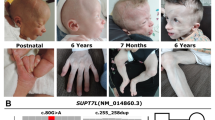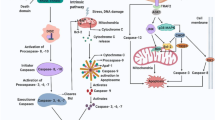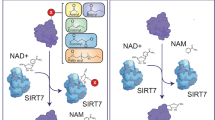Abstract
The receptor for activated C-kinase 1 (RACK1) is a conserved structural protein of 40S ribosomes. Strikingly, deletion of RACK1 in yeast homolog Asc1 is not lethal. Mammalian RACK1 also interacts with many nonribosomal proteins, hinting at several extraribosomal functions. A knockout mouse for RACK1 has not previously been described. We produced the first RACK1 mutant mouse, in which both alleles of RACK1 gene are defective in RACK1 expression (ΔF/ΔF), in a pure C57 Black/6 background. In a sample of 287 pups, we observed no ΔF/ΔF mice (72 expected). Dissection and genotyping of embryos at various stages showed that lethality occurs at gastrulation. Heterozygotes (ΔF/+) have skin pigmentation defects with a white belly spot and hypopigmented tail and paws. ΔF/+ have a transient growth deficit (shown by measuring pup size at P11). The pigmentation deficit is partly reverted by p53 deletion, whereas the lethality is not. ΔF/+ livers have mild accumulation of inactive 80S ribosomal subunits by polysomal profile analysis. In ΔF/+ fibroblasts, protein synthesis response to extracellular and pharmacological stimuli is reduced. These results highlight the role of RACK1 as a ribosomal protein converging signaling to the translational apparatus.








Similar content being viewed by others
References
Sonenberg N, Hinnebusch AG (2009) Regulation of translation initiation in eukaryotes: mechanisms and biological targets. Cell 136:731–745
Kondrashov N, Pusic A, Stumpf CR et al (2011) Ribosome-mediated specificity in Hox mRNA translation and vertebrate tissue patterning. Cell 145:383–397
Ron D, Chen CH, Caldwell J, Jamieson L, Orr E, Mochly-Rosen D (1994) Cloning of an intracellular receptor for protein kinase C: a homolog of the beta subunit of G proteins. Proc Natl Acad Sci U S A 91:839–843
Ron D, Luo J, Mochly-Rosen D (1995) C2 region-derived peptides inhibit translocation and function of beta protein kinase C in vivo. J Biol Chem 270:24180–24187
Besson A, Wilson TL, Yong VW (2002) The anchoring protein RACK1 links protein kinase Cepsilon to integrin beta chains. Requirements for adhesion and motility. J Biol Chem 277:22073–22084
Gibson TJ (2012) RACK1 research – ships passing in the night? FEBS Lett 586(17):2787–2789
Chang BY, Chiang M, Cartwright CA (2001) The interaction of Src and RACK1 is enhanced by activation of protein kinase C and tyrosine phosphorylation of RACK1. J Biol Chem 276:20346–20356
Mamidipudi V, Zhang J, Lee KC, Cartwright CA (2004) RACK1 regulates G1/S progression by suppressing Src kinase activity. Mol Cell Biol 24:6788–6798
Lopez-Bergami P, Habelhah H, Bhoumik A, Zhang W, Wang LH, Ronai Z (2005) RACK1 mediates activation of JNK by protein kinase C [corrected]. Mol Cell 19:309–320
Lopez-Bergami P, Huang C, Goydos JS et al (2007) Rewired ERK-JNK signaling pathways in melanoma. Cancer Cell 11:447–460
Yaka R, Thornton C, Vagts AJ, Phamluong K, Bonci A, Ron D (2002) NMDA receptor function is regulated by the inhibitory scaffolding protein, RACK1. Proc Natl Acad Sci USA 99:5710–5715
Reiner CL, McCullar JS, Kow RL, Le JH, Goodlett DR, Nathanson NM (2010) RACK1 associates with muscarinic receptors and regulates M(2) receptor trafficking. PLoS One 5:e13517
Angenstein F, Evans AM, Settlage RE et al (2002) A receptor for activated C kinase is part of messenger ribonucleoprotein complexes associated with polyA-mRNAs in neurons. J Neurosci 22:8827–8837
Buensuceso CS, Woodside D, Huff JL, Plopper GE, O’Toole TE (2001) The WD protein Rack1 mediates protein kinase C and integrin-dependent cell migration. J Cell Sci 114:1691–1698
Serrels B, Sandilands E, Serrels A et al (2010) A complex between FAK, RACK1, and PDE4D5 controls spreading initiation and cancer cell polarity. Curr Biol 20:1086–1092
Smith KJ, Baillie GS, Hyde EI et al (2007) 1H NMR structural and functional characterisation of a cAMP-specific phosphodiesterase-4D5 (PDE4D5) N-terminal region peptide that disrupts PDE4D5 interaction with the signalling scaffold proteins, beta-arrestin and RACK1. Cell Signal 19:2612–2624
Li X, Baillie GS, Houslay MD (2009) Mdm2 directs the ubiquitination of beta-arrestin-sequestered cAMP phosphodiesterase-4D5. J Biol Chem 284:16170–16182
Serrels B, Sandilands E, Frame MC (2011) Signaling of the direction-sensing FAK/RACK1/PDE4D5 complex to the small GTPase Rap1. Small GTPases 2:54–61
Chang BY, Conroy KB, Machleder EM, Cartwright CA (1998) RACK1, a receptor for activated C kinase and a homolog of the beta subunit of G proteins, inhibits activity of src tyrosine kinases and growth of NIH 3T3 cells. Mol Cell Biol 18:3245–3256
Mamidipudi V, Cartwright CA (2009) A novel pro-apoptotic function of RACK1: suppression of Src activity in the intrinsic and Akt pathways. Oncogene 28:4421–4433
Wehner P, Shnitsar I, Urlaub H, Borchers A (2011) RACK1 is a novel interaction partner of PTK7 that is required for neural tube closure. Development 138:1321–1327
Arimoto K, Fukuda H, Imajoh-Ohmi S, Saito H, Takekawa M (2008) Formation of stress granules inhibits apoptosis by suppressing stress-responsive MAPK pathways. Nat Cell Biol 10:1324–1332
Ohn T, Kedersha N, Hickman T, Tisdale S, Anderson P (2008) A functional RNAi screen links O-GlcNAc modification of ribosomal proteins to stress granule and processing body assembly. Nat Cell Biol 10:1224–1231
McGough NN, He DY, Logrip ML et al (2004) RACK1 and brain-derived neurotrophic factor: a homeostatic pathway that regulates alcohol addiction. J Neurosci 24:10542–10552
Robles MS, Boyault C, Knutti D, Padmanabhan K, Weitz CJ (2010) Identification of RACK1 and protein kinase Calpha as integral components of the mammalian circadian clock. Science 327:463–466
Rachfall N, Schmitt K, Bandau S, Smolinski N, Ehrenreich A, Valerius O, Braus GH (2012) RACK1/Asc1p, a ribosomal node in cellular signaling. Mol Cell Proteomics. doi:10.1074/mcp.M112.017277
Baum S, Bittins M, Frey S, Seedorf M (2004) Asc1p, a WD40-domain containing adaptor protein, is required for the interaction of the RNA-binding protein Scp160p with polysomes. Biochem J 380:823–830
Chantrel Y, Gaisne M, Lions C, Verdiere J (1998) The transcriptional regulator Hap1p (Cyp1p) is essential for anaerobic or heme-deficient growth of Saccharomyces cerevisiae: genetic and molecular characterization of an extragenic suppressor that encodes a WD repeat protein. Genetics 148:559–569
Gerbasi VR, Weaver CM, Hill S, Friedman DB, Link AJ (2004) Yeast Asc1p and mammalian RACK1 are functionally orthologous core 40S ribosomal proteins that repress gene expression. Mol Cell Biol 24:8276–8287
Nunez A, Franco A, Madrid M, Soto T, Vicente J, Gacto M, Cansado J (2009) Role for RACK1 orthologue Cpc2 in the modulation of stress response in fission yeast. Mol Biol Cell 20:3996–4009
Zeller CE, Parnell SC, Dohlman HG (2007) The RACK1 ortholog Asc1 functions as a G-protein beta subunit coupled to glucose responsiveness in yeast. J Biol Chem 282:25168–25176
Link AJ, Eng J, Schieltz DM, Carmack E, Mize GJ, Morris DR, Garvik BM, Yates JR 3rd (1999) Direct analysis of protein complexes using mass spectrometry. Nat Biotechnol 17:676–682
Sengupta J, Nilsson J, Gursky R, Spahn CM, Nissen P, Frank J (2004) Identification of the versatile scaffold protein RACK1 on the eukaryotic ribosome by cryo-EM. Nat Struct Mol Biol 11:957–962
Rabl J, Leibundgut M, Ataide SF, Haag A, Ban N (2011) Crystal structure of the eukaryotic 40S ribosomal subunit in complex with initiation factor 1. Science 331:730–736
Jannot G, Bajan S, Giguere NJ, Bouasker S, Banville IH, Piquet S, Hutvagner G, Simard MJ (2011) The ribosomal protein RACK1 is required for microRNA function in both C. elegans and humans. EMBO Rep 12:581–586
Kuroha K, Akamatsu M, Dimitrova L, Ito T, Kato Y, Shirahige K, Inada T (2010) Receptor for activated C kinase 1 stimulates nascent polypeptide-dependent translation arrest. EMBO Rep 11:956–961
Ceci M, Gaviraghi C, Gorrini C, Sala LA, Offenhauser N, Marchisio PC, Biffo S (2003) Release of eIF6 (p27BBP) from the 60S subunit allows 80S ribosome assembly. Nature 426:579–584
Ruan Y, Sun L, Hao Y et al (2012) Ribosomal RACK1 promotes chemoresistance and growth in human hepatocellular carcinoma. J Clin Invest 122:2554–2566
Grosso S, Volta V, Sala LA, Vietri M, Marchisio PC, Ron D, Biffo S (2008) PKCbetaII modulates translation independently from mTOR and through RACK1. Biochem J 415:77–85
Biffo S, Sanvito F, Costa S, Preve L, Pignatelli R, Spinardi L, Marchisio PC (1997) Isolation of a novel beta4 integrin-binding protein (p27(BBP)) highly expressed in epithelial cells. J Biol Chem 272:30314–30321
Strezoska Z, Pestov DG, Lau LF (2002) Functional inactivation of the mouse nucleolar protein Bop1 inhibits multiple steps in pre-rRNA processing and blocks cell cycle progression. J Biol Chem 277:29617–29625
Gandin V, Miluzio A, Barbieri AM, Beugnet A, Kiyokawa H, Marchisio PC, Biffo S (2008) Eukaryotic initiation factor 6 is rate-limiting in translation, growth and transformation. Nature 455:684–688
Miluzio A, Beugnet A, Grosso S et al (2011) Impairment of cytoplasmic eIF6 activity restricts lymphomagenesis and tumor progression without affecting normal growth. Cancer Cell 19:765–775
Biffo S, Verhaagen J, Schrama LH, Schotman P, Danho W, Margolis FL (1990) B-50/GAP43 expression correlates with process outgrowth in the embryonic mouse nervous system. Eur J Neurosci 2:487–499
Biffo S, DeLucia R, Mulatero B, Margolis F, Fasolo A (1990) Carnosine-, calcitonin gene-related peptide- and tyrosine hydroxylase-immunoreactivity in the mouse olfactory bulb following peripheral denervation. Brain Res 528:353–357
Sanvito F, Piatti S, Villa A, Bossi M, Lucchini G, Marchisio PC, Biffo S (1999) The beta4 integrin interactor p27(BBP/eIF6) is an essential nuclear matrix protein involved in 60S ribosomal subunit assembly. J Cell Biol 144:823–837
Oliver ER, Saunders TL, Tarle SA, Glaser T (2004) Ribosomal protein L24 defect in belly spot and tail (Bst), a mouse Minute. Development 131:3907–3920
Guo J, Wang S, Valerius O et al (2011) Involvement of Arabidopsis RACK1 in protein translation and its regulation by abscisic acid. Plant Physiol 155:370–383
Caldarola S, De Stefano MC, Amaldi F, Loreni F (2009) Synthesis and function of ribosomal proteins—fading models and new perspectives. FEBS J 276:3199–3210
Kiss T, Fayet-Lebaron E, Jady BE (2010) Box H/ACA small ribonucleoproteins. Mol Cell 37:597–606
Adams DR, Ron D, Kiely PA (2011) RACK1, a multifaceted scaffolding protein: structure and function. Cell Commun Signal 9:22
Brejning J, Arneborg N, Jespersen L (2005) Identification of genes and proteins induced during the lag and early exponential phase of lager brewing yeasts. J Appl Microbiol 98:261–271
Kleinschmidt M, Schulz R, Braus GH (2006) The yeast CPC2/ASC1 gene is regulated by the transcription factors Fhl1p and Ifh1p. Curr Genet 49:218–228
Mabuchi T, Ichimura Y, Takeda M, Douglas MG (2000) ASC1/RAS2 suppresses the growth defect on glycerol caused by the atp1-2 mutation in the yeast Saccharomyces cerevisiae. J Biol Chem 275:10492–10497
Valerius O, Kleinschmidt M, Rachfall N et al (2007) The Saccharomyces homolog of mammalian RACK1, Cpc2/Asc1p, is required for FLO11-dependent adhesive growth and dimorphism. Mol Cell Proteomics 6:1968–1979
Nilsson J, Sengupta J, Frank J, Nissen P (2004) Regulation of eukaryotic translation by the RACK1 protein: a platform for signalling molecules on the ribosome. EMBO Rep 5:1137–1141
Matsson H, Davey EJ, Draptchinskaia N et al (2004) Targeted disruption of the ribosomal protein S19 gene is lethal prior to implantation. Mol Cell Biol 24:4032–4037
Ellis SR, Gleizes PE (2011) Diamond Blackfan anemia: ribosomal proteins going rogue. Semin Hematol 48:89–96
Barkic M, Crnomarković S, Grabusić K et al (2009) The p53 tumor suppressor causes congenital malformations in Rpl24-deficient mice and promotes their survival. Mol Cell Biol 29:2489–2504
Egidy G, Julé S, Bossé P et al (2008) Transcription analysis in the MeLiM swine model identifies RACK1 as a potential marker of malignancy for human melanocytic proliferation. Mol Cancer 7:34
Lee JH, Cho B, Jun HJ, Seo WD, Kim DW, Cho KJ, Lee SJ (2012) Momilactione B inhibits protein kinase A signaling and reduces tyrosinase-related proteins 1 and 2 expression in melanocytes. Biotechnol Lett 34:805–812
Bolger GB, Baillie GS, Li X et al (2006) Scanning peptide array analyses identify overlapping binding sites for the signalling scaffold proteins, beta-arrestin and RACK1, in cAMP-specific phosphodiesterase PDE4D5. Biochem J 398:23–36
Lynch MJ, Baillie GS, Mohamed A, Li X, Maisonneuve C, Klussmann E, van Heeke G, Houslay MD (2005) RNA silencing identifies PDE4D5 as the functionally relevant cAMP phosphodiesterase interacting with beta arrestin to control the protein kinase A/AKAP79-mediated switching of the beta2-adrenergic receptor to activation of ERK in HEK293B2 cells. J Biol Chem 280:33178–33189
Levitt JM, Baldwin A, Papadakis A, Puri S, Xylas J, Munger K, Georgakoudi I (2006) Intrinsic fluorescence and redox changes associated with apoptosis of primary human epithelial cells. J Biomed Opt 11:064012
Acknowledgments
This work was supported by grants AIRC IG11390 (Associazione Italiana Ricerca sul Cancro), AICR (Association for International Cancer Research, UK) 09-0061, and TELETHON GGP05043 to S.B. We thank Dr. Dorit Ron (UCSF, San Francisco, USA) for helpful suggestions. Requests concerning reagents or mice should be addressed to S.B. or V.V.
Author information
Authors and Affiliations
Corresponding author
Additional information
V. Volta and A. Beugnet contributed equally to this work.
Rights and permissions
About this article
Cite this article
Volta, V., Beugnet, A., Gallo, S. et al. RACK1 depletion in a mouse model causes lethality, pigmentation deficits and reduction in protein synthesis efficiency. Cell. Mol. Life Sci. 70, 1439–1450 (2013). https://doi.org/10.1007/s00018-012-1215-y
Received:
Revised:
Accepted:
Published:
Issue Date:
DOI: https://doi.org/10.1007/s00018-012-1215-y




